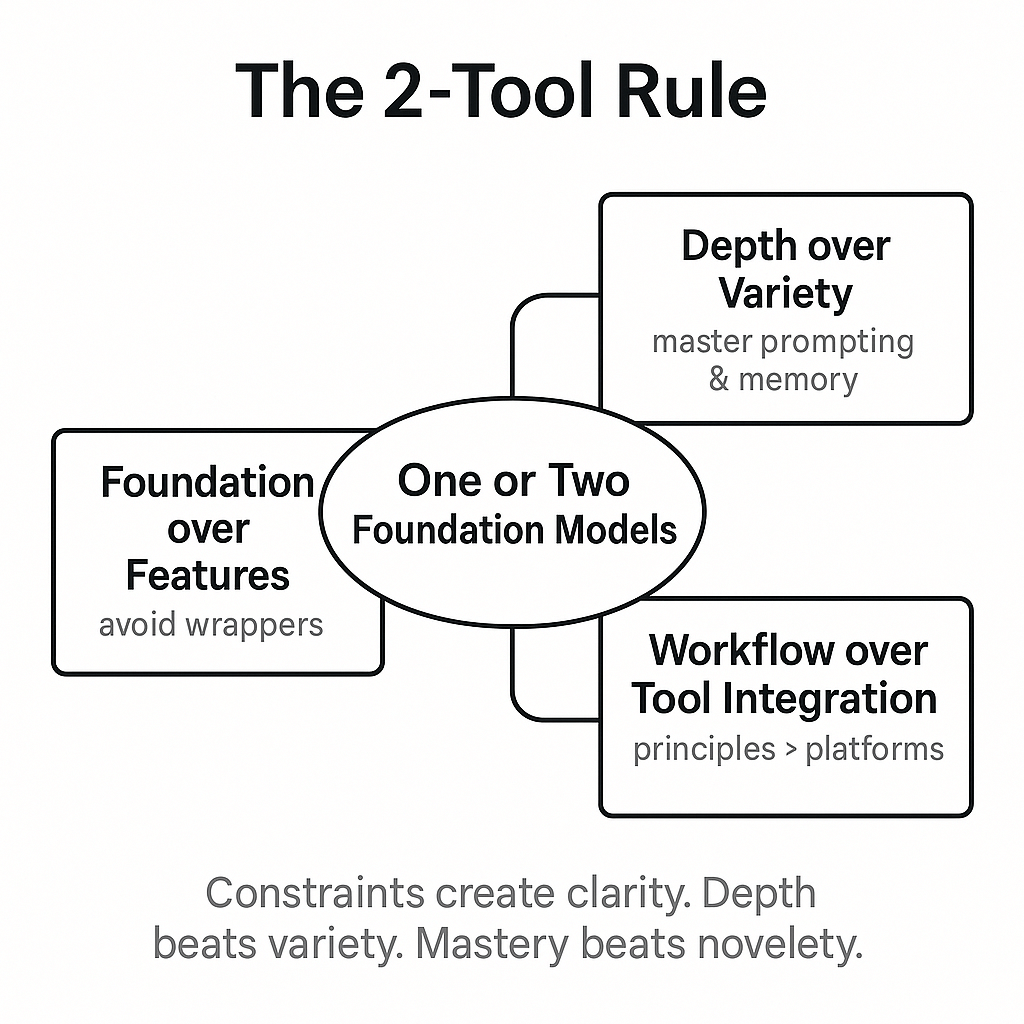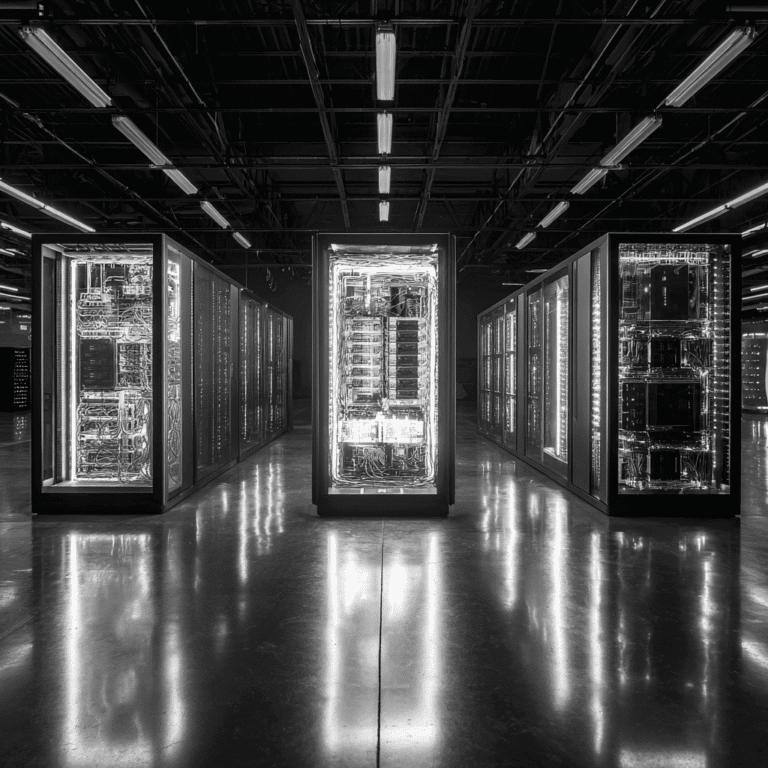Why More AI Tools Make You Less Productive (And the 2-Tool Rule That Fixes It)

AI promised to simplify your work. Instead, you’re drowning in subscriptions.
Seven different AI tools. Four dashboards. Three browser tabs just to write an email. You’re paying for speed but bleeding focus. This isn’t leverage, but digital hoarding disguised as productivity.
Most solo builders think the solution is finding better tools. The real solution is using fewer of them. After evaluating enterprise AI stacks worth 7-figures and forcing myself to build projects solo with a $20 monthly budget, I’ve learned this: constraints create clarity, not limitation.
The AI Tool Trap: Why More Tools Mean Less Focus
The pattern is predictable. A new AI tool launches with promises of unfair advantage. The demo looks impressive. You subscribe.
Week one feels productive. Week two brings friction when your new tool doesn’t integrate with your existing workflow. Week three means learning another interface, another prompt style, another set of limitations.
Meanwhile, three more “revolutionary” tools have launched. Each demands evaluation. Each promises to solve problems you didn’t know you had.
The result isn’t productivity. It’s tool paralysis.
You’re spending more time managing and optimizing your AI stack than building with it. Decision fatigue replaces creative flow. Your workflows become fragile chains of dependencies rather than robust systems.
Why Tool Proliferation Kills Focus
Every new AI tool in your stack creates cognitive overhead. Not just the subscription cost, but also the mental cost of context switching between different interfaces, prompt formats, and capabilities.
Your brain treats each tool switch as a separate decision.[1] Should I use Tool A or Tool B for this task? Which one handles this edge case better? Where did I save that output from last week?
This isn’t efficiency. It’s attention arbitrage, trading focused deep work for shallow tool management.
The productivity research is clear: cognitive switching penalties compound. Each additional tool in your workflow doesn’t just add its own switching cost. It multiplies the decision complexity of every other tool choice.[2]
The instability gets worse. AI tool rankings shift daily. Today’s “best” AI tool becomes tomorrow’s inferior option when a new model launches. Your carefully optimized workflow—the one you spent weeks perfecting—gets demolished by a benchmark update or feature announcement.
You’re not just managing tools anymore. You’re chasing a moving target where your “optimal” stack becomes obsolete faster than you can master it. The tools change. Your workflows break. Your expertise becomes worthless.
The Enterprise Lesson: How Big Companies Simplify AI Stacks
At enterprise scale, companies learn this lesson expensively. Teams advocate for specialized AI tool stacks to solve specific problems. Marketing wants one tool stack. Sales wants another. Engineering needs something different.
Within months, they had scattered workflows, inconsistent outputs, and integration nightmares. Worse, teams become tool-dependent rather than skill-dependent. When tools break or change, productivity collapses.
The fix is not better tool selection. It was tool reduction.
Successful enterprise AI implementations focus on depth over breadth. Two or three foundation models, mastered completely, outperform ten specialized tools used superficially.
This principle scales down perfectly for solo builders.
The 2-Tool Rule: A Framework for Real Productivity
Here’s the framework I use for both enterprise teams and solo building: Pick one or two foundation models and master them completely.
Don’t collect AI tools. Develop AI fluency.
Principle 1: Focus on Foundation Over Features
Most AI SaaS tools are wrapper interfaces around the same underlying language models. You’re paying for convenience features you could build yourself with proper prompting techniques.
Instead of subscribing to five different writing tools, learn to prompt one model effectively for different writing tasks. Instead of using separate tools for research, analysis, and synthesis, develop prompt chains that handle all three workflows.
Principle 2: Prioritize Depth Over Variety
The power of AI isn’t in having many specialized tools. It’s in understanding how to make one powerful model adapt to your specific needs.
Master prompt chaining. Learn memory control. Develop systematic approaches to complex tasks. These skills compound across every project. Tool-specific features don’t transfer.
Principle 3: Build for Workflow, Not Tool Integration
Build your AI workflows on top of foundation models, not around specialized SaaS platforms. This creates resilience. When a tool shuts down or changes pricing, your core skills and workflows survive.
Your process should depend on principles, not platforms.

The Constraint Advantage
Limitations force innovation. When you can’t solve a problem by downloading another app, you get creative with the tools you have.
This constraint-driven approach produces three benefits most builders miss:
1. Deeper Expertise: You become genuinely skilled at AI implementation instead of superficially familiar with many interfaces.
2. Reduced Friction: Your workflows become muscle memory. No time wasted comparing options or learning new interfaces.
3. Strategic Thinking: You solve problems through systematic approaches rather than hoping the right tool exists.
When you use AI to surface patterns in your own logs instead of relying on specialized pattern-detection SaaS, you develop judgment. When you build your own automation workflows instead of subscribing to automation platforms, you understand the logic.
Your Implementation Plan: From Audit to Optimization
Start with audit, not addition. List every AI tool you currently pay for. For each one, ask: What specific workflow does this enable that I couldn’t accomplish with a foundation model and better prompting?
Most tools won’t survive this filter.
Phase 1: Tool Consolidation
Cancel subscriptions for tools that duplicate core model capabilities. Keep only tools that provide unique data access or integration features you can’t replicate.
When in doubt, run a test for picking durable systems and keep only what survives.
Phase 2: Skill Development
Invest the time you previously spent tool-shopping in developing advanced prompting techniques. Learn to chain prompts effectively. Study how to maintain context across long conversations.
Phase 3: Workflow Optimization
Build repeatable processes using your foundation models. Document your best prompt templates. Create systems that produce consistent output quality without requiring multiple tools.
This isn’t about using fewer tools for the sake of minimalism. But convert failures into checklists you paste into prompts under pressure.
The Long-Term Advantage of AI Skill-Building
The companies that deploy AI successfully don’t have the most tools. They have the clearest implementation frameworks.
They focus on reproducible processes over feature-rich platforms. They train teams on principles, not specific tool interfaces. They measure output quality and workflow reliability, not tool adoption metrics.
Solo builders can apply the same strategic thinking. Your competitive advantage isn’t in having access to more AI tools than your competitors. It’s in using foundational tools more effectively than they do.
The Focus Recovery Framework
If you’re already experiencing AI tool fatigue, here’s how to recover your focus:
Week 1: Identify your two most essential AI tools. These should be foundation models, not specialized wrappers.
Week 2: Pause all other AI tool subscriptions. Don’t cancel yet, just stop using them.
Week 3: Force yourself to accomplish your normal AI-assisted tasks using only your two chosen tools. Document what feels difficult or impossible.
Week 4: Evaluate what you actually missed. Most of the time, it’s convenience features, not core capabilities.
If overwhelm spikes during the reset, reduce friction by taking one controlled next move and keep momentum without expanding your stack.
Most builders discover they can accomplish 90% of their AI-assisted work with one well-understood foundation model and systematic prompting approaches.
When Tool Reduction Isn’t Limitation
Constraint isn’t the enemy of capability. It’s the foundation of mastery.
Jazz musicians create better improvisations within structured chord progressions than in complete musical freedom. Writers produce clearer prose within format constraints than with unlimited word counts.
AI builders develop better solutions within tool constraints than with unlimited SaaS access.
The goal isn’t to artificially limit yourself. It’s to focus your learning and problem-solving energy on developing transferable skills rather than collecting platform-specific features.
When you master foundation models deeply, you can adapt to any AI advancement. When you collect specialized tools superficially, every market shift breaks your workflow.
Building for the Long Term
AI tool landscape changes rapidly. New models launch monthly. SaaS companies pivot or disappear. Pricing structures shift without warning.
Skills compound. Tools don’t.
The frameworks you develop for systematic prompting will work regardless of which specific language model becomes dominant. The process thinking you build will transfer across any AI advancement.
Tool-dependent workflows create fragility. Skill-dependent approaches create antifragility—they get stronger under stress rather than breaking.
Your edge as a solo builder isn’t in having more tools than your competition. It’s in using fundamental tools more systematically than they do.
Simple beats complex. Depth beats variety. Mastery beats novelty.
The builders who thrive in the AI era won’t be the ones who collected the most subscriptions. They’ll be the ones who developed the clearest thinking about how to leverage intelligence—artificial or otherwise—to solve real problems.
Stop optimizing your tool stack. Start optimizing your cognitive stack. The foundation models will get better. Your systematic thinking about how to use them will get better too.
That’s how you build AI leverage that lasts longer than the next product launch.
Frequently Asked Questions
1. What is the 2-Tool Rule for AI?
The 2-Tool Rule is a productivity framework that advises focusing on mastering one or two powerful foundation models (like GPT-4 or Claude 3) instead of subscribing to many specialized AI apps. The goal is to build transferable skills rather than relying on tool-specific features.
2. Why do too many AI tools hurt productivity?
Each new tool adds cognitive overhead. You spend more time switching between interfaces, learning different prompt styles, and managing subscriptions than doing deep work. This “tool paralysis” leads to decision fatigue and fragile, easily broken workflows.
3. What’s the difference between a foundation model and a “wrapper” tool?
A foundation model is the core AI engine (e.g., GPT-Version number). A “wrapper” tool is a SaaS application built on top of a foundation model, usually offering a nice interface for a specific task like writing social media posts. By mastering the foundation model, you can often replicate the functions of many wrapper tools with effective prompting.
4. How can I start consolidating my AI tools today?
Begin with a tool audit. List all your AI subscriptions and ask for each one: “Does this provide a core capability I can’t get from my primary foundation model?” Cancel any tools that are redundant. Your goal is to keep only what is absolutely essential.
5. Is it ever okay to use more than two AI tools?
Yes, if the additional tools provide unique, irreplaceable value that your foundation models cannot. This could be access to proprietary data, crucial hardware integrations (like in AI art generation), or highly specialized scientific analysis. The “rule” is a guideline to enforce strategic thinking, not a rigid law.






